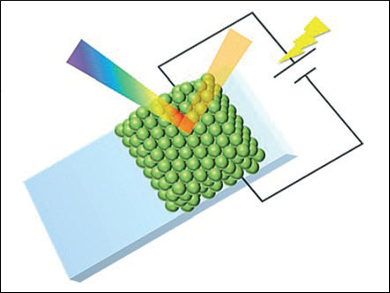Photonic crystals produce different colors by the interaction of light with their internal structures, and the colors can be manipulated by modifying the periodicity of the crystals. Conducting polymers have electrochromic properties, however, the colors are limited by the type of polymer used.
Mahito Atobe and colleagues, Yokohama National University and Kyushu University, Japan, set out to investigate what happens when structurally colored photonic crystals and electrochromic conducting polymers were combined. The researchers produced core–shell nanoparticles comprising a polyaniline (PANI) core and poly(methyl methacrylate) (PMMA) shell.
PMMA cores of different sizes were formed by using a technique involving soap-free emulsion polymerization and acoustic emulsification. PANI was subsequently deposited on the surfaces. Colloidal crystal films of the PANI@PMMA core–shell nanoparticles showed various colors ranging from greenish-yellow (248 nm), through light green (220 nm), to light blue (201 nm). Application of voltages to these films resulted in electrochromic color changes that are different to those of pure PANI.
The combination of the ordered arrays in the colloidal crystals and the electrochromism of the PANI layers thus results in unique behavior not observed for the individual components.
- Electroresponsive Structurally Colored Materials: A Combination of Structural and Electrochromic Effects,
Tomoya Kuno, Yoshimasa Matsumura, Koji Nakabayashi, Mahito Atobe,
Angew. Chem. Int. Ed. 2016.
DOI: 10.1002/anie.201511191




